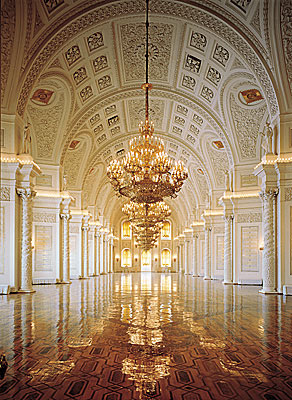|
|||
|
Philatelia.Net / Bonapart / Plots / The directory «Plots of stamps in the catalogue»The Georgievsky Hall of the Grand Kremlin PalaceThe stunning, yellow-and-white Russo-Byzantine facade of the Grand Kremlin Palace stands on the crest of Borovitsky Hill in the southern part of the Kremlin complex. The palace on view today was commissioned in 1837 by Emperor Nicholas I, but stands on the site of the estate of the Grand Princes, established as far back as the 14th century. At the start of the 1300s, with Ivan Kalita's marriage to the Tatar Khan's daughter and his assumption of the title of Great Prince of Vladimir, the royal estate consisted of a number of log houses with porches and turrets interconnected with vestibules, stairways and passages. The western wing of the palace features the Imperial family's private apartments and five grandiose state reception rooms, each dedicated to one of the chivalric orders of the Empire. From the palace's central entrance on the building's southern facade, a grandiose staircase leads up to the second floor and the magnificent Georgievsky Hall. Named after the Order of St, George, the highest Russian military decoration, the hall covers an impressive 1,250 meters of floor space and its ceiling is a mighty 7.5 meters high. The hall is adorned with hollow zinc columns and lit by a host of ornate crystal chandeliers, whose light reflects in the room's intricately patterned parquet floor, the design of which incorporates twenty different kinds of wood. The hall's walls feature numerous marble plaques on which are engraved in gold the names of Russian units that distinguished themselves in battle, and of officers and men awarded the Order of St. George. Among them are the names of the famous Russian army commanders Field Marshals Suvorov and Kutuzov, and the navy commander Admiral Nakhimov. Elegant columns are interspersed between the marble inscriptions, each crowned with an allegorical statue of a woman holding a laurel wreath in her hands and personifying the victories won by the Russian army. The Georgievsky Hall is used for state and diplomatic receptions and official ceremonies such as the presentation of governmental awards and state prizes. After the World War Two Victory Parade in 1945 the participants attended a reception held in this hall. It was also here that Yuri Gagarin, the first man to orbit the Earth in space, received his Gold Star of the Hero of the Soviet Union in 1961. USSR, 1957. 07.08, USSR, 1978.03.12, Advertising: |
|||
© 2003-2025 Dmitry Karasyuk. Idea, preparation, drawing up
|

